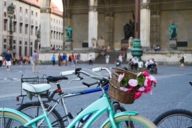
Why is Munich known as Italy’s most northerly city? Stand on Odeonsplatz square soaking up the spectacular scenery around you and you’ll understand why.
Ever since he travelled to Rome for his studies, art-loving King Ludwig I held a deep affection for Italy. In 1816, while he was still Crown Prince, he commissioned Leo von Klenze to design Ludwigstrasse in its entirety. The grand boulevard was designed to form a single architectural unit with the square at Odeonsplatz.
Like the sweeping Bazargebäude (Bazaar Building) to the east and the Palais Leuchtenberg in the west (based on the Palazzo Farnese in Rome), the Roman-inspired neoclassical buildings that line both sides of Ludwigstrasse evoke images of Italy.
The southern end of square is bordered by the Feldherrnhalle (Field Marshalls’ Hall). Friedrich von Gärtner, King Ludwig I’s second court architect after von Klenze, designed this building in the style of the Loggia dei Lanzi in Florence. The building was completed in 1844 and erected in honour of the Bavarian army.
The Theatinerkirche (Theatine Church) also pays homage to the south, though it was built a few centuries before the rest of the square. It was the first church north of the Alps to be designed in the Late Baroque style from Italy. As a symbol of gratitude following the birth of a new heir to the throne, Electress Henriette Adelheid of Savoy commissioned the church to be built for the Roman order of the Theatines at the end of the 1600s.
The square itself was named after the former Odeon concert hall, which King Ludwig I had built on the south-west side of the square in the early 19th century. The hall sustained heavy damage during the Second World War and was converted into the headquarters for the Bavarian Ministry of the Interior once the war was over.
A number of other landmarks are located within a stone’s throw of Odeonsplatz, including the Nationaltheater (Opera House) and the Residenz palace with the Hofgarten, which was created in the early 1600s and inspired by Italian renaissance gardens.
The Palais Ludwig Ferdinand on Wittelsbacher Platz, the current Siemens AG headquarters, marks the entrance to the Brienner district, which is home to a number of exclusive, traditional shops and Münchner Literaturhaus (Munich Literature House).
Tip: One weekend every July, Munich’s best open-air concert hall becomes the backdrop for “Klassik am Odeonsplatz” (a classical music event), featuring two of Munich’s top orchestras and world-famous classical music stars.